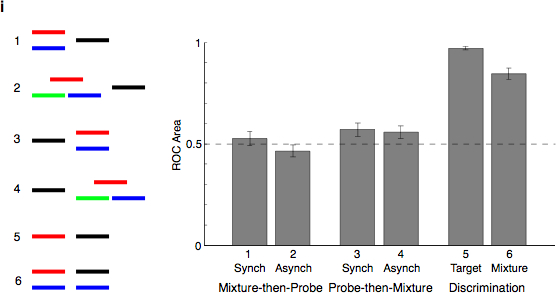Source Repetition Stimuli Examples - Figure 1i
These pages contain example stimuli from the paper "Recovering Sound Sources From Embedded Repetition" by McDermott, Wrobleski, and Oxenham (2011, PNAS). Headphones are recommended. Quicktime must be installed for the sounds to play.
**Please note - sound files make take a few seconds to load. If not all sounds load, please try refreshing the page.**
Figure 1i (Experiment 1)

Fig. 1i. Results and stimulus configurations from Experiment 1. Line segments represent sounds; sounds presented at the same time are drawn vertically displaced. Red segments represent target sounds. Black segments represent probe sounds. Different colors represent different sounds. Error bars here and elsewhere denote standard errors. Dashed line denotes chance performance level.
Experiment 1 stimulus examples
There are two examples of each condition. In Conditions 1-4, the probe stimulus is the target (i.e., these would all be trials where the probe sound is one of the sounds in the mixture). Note that what you hear in the mixture generally does not sound like the target sound - the sounds composing the mixtures do not segregate. When the probe is presented first, you may think you hear it in the mixture, but the results suggest that this is also the case for the false probes. In Conditions 5 and 6, the probe is a false probe. You should be able to tell that the two sounds in each example are not the same.
| Condition 1: | Condition 3: | ||||
| Condition 2: | Condition 4: | ||||
| Condition 5: | Condition 6: |
Stimuli from Figure 1a-h Stimuli from Figure 2a Stimuli from Figure 2b Stimuli from Figure 3a
Stimulifrom Figure 3b Stimuli from Figure 4 Stimuli from Figure S3a Stimuli from Figure S3b
Back